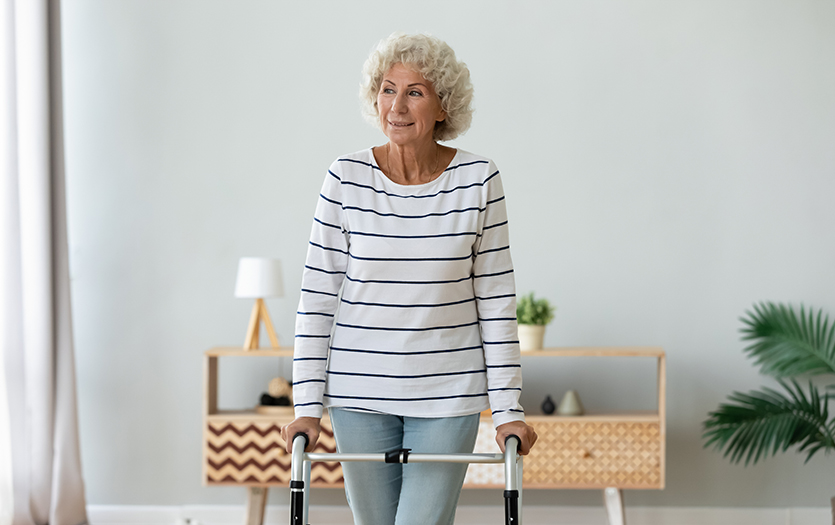
This post was written by Jason Heisler, MD, orthopedic surgery, Orthopedics NorthEast.
At Parkview, we perform surgery to address over 500 hip fractures a year—that's a huge number. We see these across a bimodal distribution, meaning two key groups. I want to dig into the most common at-risk population a little deeper and discuss how these individuals can reduce their risk of a fracture, while also dispelling the most common myth related to these injuries.
Who’s at risk for a hip fracture?
The first group we see is young people, in their twenties, thirties and forties. These tend to be trauma-related, such as car accidents, falls from high up, etc. We would consider these high-energy hip fractures.
The second group, which is vastly more common, is older individuals, 65+. These injuries are typically low-energy, such as tripping over a step, falling from standing, or getting a cord or dog leash wrapped around their legs. Hip fractures in the second group are usually related to osteoporosis or weakened bones.
Prevention
It seems obvious, but the most important thing is to avoid falls altogether. From a safety standpoint, there are definitely measures people can take. Practice proper procedures and be aware whenever you’re going to participate in activities that make you vulnerable to falling, such as being on ladders or a roof.
Looking at the bigger at-risk population, we see more modifiable factors and prevention strategies.
Identify the risk and seek resources.
With our older adults, we often can identify if a patient is displaying signs of elevated fall risk, such as an unsteady gait, weakness, previous falls or occasional dizziness. Parkview has a Fall Prevention Clinic to help address some of these issues and provide general tips for setting the home up in the safest way possible.
Reduce fall hazards at home.
We encourage our older or fall-risk patients to take precautions like removing rugs from the home, having proper lighting, installing grab bars in specific areas, such as next to the toilet or near steps, and moving to the lower level if they haven’t already.
Get more tips for preventing falls here.
Stay strong.
Maintaining strength is also crucial to prevent falls as we age. We tend to become less active as we get older, which leads to a gradual loss of muscle and body control. This weakness can mean our gait gets less steady, our balance suffers and it’s harder to recover when we get off center. Work to maintain muscle and stay strong.
Read: How to preserve muscle as you age.
Lean on an assistive device.
If you need a cane or walker for assistance, use it! An assistive device can be an invaluable tool for getting around your home or an environment you aren’t used to outside of your home.
Be mindful of bone density.
As mentioned above, osteoporosis is common in our older population. Patients can reduce their risk of losing bone mass and managing the diagnosis once they have it by getting adequate amounts of vitamin D and calcium, particularly men over 75 and post-menopausal women. Regular movement can also help protect your bones. Just walking for 15-30 minutes daily can do wonders for bone density. If you’ve been diagnosed with osteoporosis or osteopenia, be sure to manage the condition by following the medication and lifestyle modifications in your care plan.
See more strategies for maintaining bone health.
Manage medical conditions.
Additionally, for those who have had a stroke, there can be some weakness that elevates an individual’s risk for falls. If they have a diagnosis like Parkinson’s disease, this can also impact how steady someone is on their feet. Managing any conditions through medication, therapies and home modifications for safety all help reduce the risk of falling and suffering a hip fracture.
The biggest myth about hip fractures
I’m sure you’ve heard someone attach the occurrence of a broken hip to a rapid decline and eventual death. People refer to this type of fracture, particularly in the elderly as, “the beginning of the end.” But I’m here to tell you that’s not necessarily true.
The majority of hip fractures are going to require surgery. Ultimately, if you do not operate on the patient, there's about a 50% mortality rate in the next three months. But we have a lot of literature that indicates that older adults who fall and break their hip, get them fixed quickly and get up to walk soon after the procedure have better outcomes.
A swift response and rehabilitation help eliminate some of the comorbidities that contribute to poor outcomes, like bed sores, blood clots, pneumonia and urinary tract infections. It’s not necessarily the break that can lead to mortality but the complications that follow the injury.
Our goal is to fix hip fractures within 24 hours of a patient presenting in the hospital. Then we repair the break in a way that enables them to get up and walk immediately so that they can get moving and rehabilitate in a timely manner.
So, to dispel the myth once and for all, I have thousands of patients who have survived a hip fracture and lived for years beyond the injury. (Don’t believe everything you hear!)
To schedule orthopedic care in Allen County, call Ortho NorthEast at 260-484-8551 or request an appointment here, or visit this page to find orthopedic care outside of Allen County.



